
John Woodall's Medicine Chest Ingredients: 1 2 3 4 Next>>
John Woodall's Medicine Chest Ingredients, Page 1
"Teach [Blackbeard] detained all the Ships and Prisoners [he took in Charlestown Harbor in May of 1718], and, being in want of Medicines,
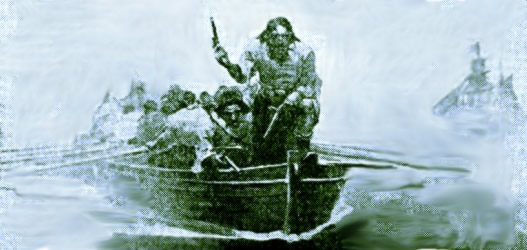
Blackbeard Approaching, from Blackbeard Buccaneer, p.309 (1922)
resolves to demand a Chest from the Government of the Province, accordingly Richards, the Captain of the Revenge Sloop, with two or three more Pvrates, were sent up along with Mr. Marks one of the Prisoners, whom they had taken in Clark's Ship, and very insolently made their Demands, threatning, that if they did not send immediately the Chest of Medicines, and let the Pyrate-Ambassadors return, without offering any Violence to their Persons, they would murder all their Prisoners, fend up their Heads to the Governor, and set the Ships they had taken on Fire." (Captain Charles Johnson, The General History of the Pirates, 3rd edition, p. 73)
The medicine chest held great importance to pirates; so much that it features in several different accounts from the golden age of piracy. In fact, the chest was held in great esteem by most sailors throughout the age of sail. Yet we have no extant examples of these chests of cures and must rely on the most basic descriptions of them and the elements included provided by authors from that time. Fortunately, John Woodall, the author of the first English sea surgeon's manual The surgions mate, has not only given a list of ingredients, but has provided a chart designating the location of many of his recommended medicines. We will examine some of the general aspects of the apothecary or medicine chest and then give detailed information on the purpose Woodall ascribed to the medicines included along with information on how they were composed.
The Importance of the Medicine Chest at Sea
"I say, although you must carry sufficient quantities of Medicines proper for every Accident and Ailment that doth usually befall at Sea, yet in a special manner you must provide for the Accidents and Distempers that may be expected in the Voyage, or expedition you are now upon." (John Moyle, Abstractum Chirurgæ Marinæ, p. 6)
If
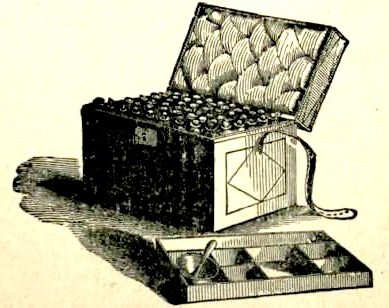
A Post-Period Medicine Chest (With Plaster Box in Foreground)
the surgeon was important to the men on a sailing vessel, his medicine chest was his most important tool. It was mentioned by those who coordinated and financed sea voyages, the sailors who worked the ship and even the pirates who captured such vessels.
Before the reign of Charles I (1625-49), "conditions were still so bad that it was not unknown for the surgeons to desert. There were often no stores, no drugs, poor food and the living quarters were filthy and inadequate."1 At that time captains would hire a surgeon just to improve the morale of the crew. "[E]ven the existence of a medicine chest was better than nothing."2
Writing just before the beginning of the golden age of piracy in 1688, Nathaniel Boteler advised that
every ship [was to be] provided with an able Chirurgeon with his Mate, to be continually resident aboard, who is to have his chest every way well furnished; that so as any person, either common man or common officer shall happen to fall sick, and especially of a sickness known or suspected to be infectious and contagious in any ship of the squadron, he may be speedily and with the first opportunity removed and received into that hospital ship which is appointed for it; the sound, but likewise be the beter lodged and looked unto by the Chirurgeon."3
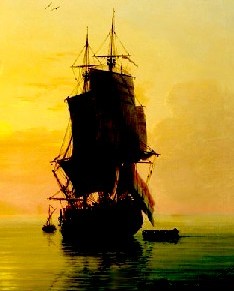
Artist: Claude-Joseph Vernet
A Calm at a Mediterranean Port (1770)
Here, Boteler mentions three elements he considered important regarding medicine on a vessel: the surgeon, his mate (or assistant) and his medicine chest. Boteler felt the chest was the best defense against communicable disease running rampant in such a closed community. Writing just after the golden age, sea surgeon John Atkins advised the the medicine chest contain "Precious Ointments, Myrrh, Aloes and Frankincense locked and sealed up by the Hall, the Key is given by a Servant to Peel Garlick, enclosed and directed to his Commander"4.
The men found comfort in its presence as well. In 1628, "the crew of the HMS Rainbow actually deserted from the ship because it had become known that the medicine chest was empty."5
Even greater testaments to the value of the medicine chest come from the accounts of the pirates from the golden age of piracy. Just as Blackbeard held Charleston for ransom to procure a medicine chest, several other pirate accounts detail how important the apothecary chest was to these rogues .
Like Blackbeard, Edward Low held a ships for ransom in order to procure a medicine chest, pressing some of their crew into service.
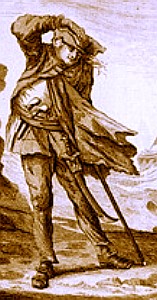
Artist: Joseph Nicholls
Pirate Captain Edward Low
(1736)
After a time Low came to anchor off the island of Santa Cruz and while laying there took it into his head that he wanted a new doctor’s chest. Shortly before he had captured two French sloops which were then at anchor near him. So putting four Frenchmen in one of the sloops and handing them some money, he ordered them to make all haste to buy a doctor’s chest at St. Thomas, about twelve leagues distant, swearing that if they didn’t bring back the chest the other sloop should be burnt and the rest of the Frenchmen killed. To his great amusement within twenty-four hours they returned with the chest and according to promise the sloops and Frenchmen were then allowed to go.6
East India Company captain James Macrae took his Indiaman the Cassandra to the Island of Comoros in hopes of catching Olivier Levasseur's crew, reported to be vulnerable while careening his ship. He instead found Edward England and a consort, the Fancy, a long and bloody battle ensued in which Macrae lost his ship to the pirates. Because England remembered Macrae and thought him honorable, the pirates gave him their damaged ship Fancy, keeping the better ship Cassandra and the large amount of silver she had aboard. However, Applebee's Original Weekly Journal reported, that "no Part of the Cargo was so much valued by the Robbers as the Doctor’s Chest, for they were all pox’d to a great Degree."7
Two decades earlier, while William Kidd was anchored off Madagascar near fellow pirate Robert Culliford, a majority of Kidd's crew decided to abandon him for Culliford's service, likely due to Kidd's capricious temper and relatively poor judgment. They not only left Kidd's service, they went aboard his ship Adventure Galley and his prize ship, the Quedah Merchant, "and carried away great guns, Powder, Shot, small Armes, Sailes, Anchors, Cables, Chirurgeons Chest, and what else they pleased"8.
Two surgeons who took the extraordinary step of volunteering to serve as voluntary surgeons for Bartholomew Robert's fleet - Peter Scudamore and George Wilson - each made a point to take the chests of medicines when the pirates captured ships.
Scudamore, as seems to befit his nature, shifts the blame for his theft. During his court trial, it explains that "The King Solomon [ship's] and Elizabeth [ship's] Medicine-Chest, he owns [agrees] he plundered, by Order of Hunter, the then chief Surgeon, who, by the Pyrates Laws,
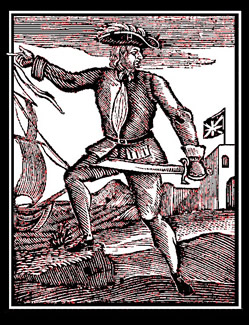
Pirate Captain Howell Davis (1728)
From The General History of the Pirates
always directs in this Province, and Mr. [William] Child, (tho' acquitted) had by the same Orders taken out a whole French Medicine-Chest, which he must be sensible for me, as well as for himself"9.
When fellow volunteer pirate ship's surgeon George Wilson joined Robert's crew, in order "to oblige his new Company, had presently ask'd for the Pyrates Boat, to fetch the Medicine Chest away"10.
Of course, pirates had some significant disadvantages when it came to medicine chests. First, they were in a business that, combined with their unruly lifestyle, lent itself to wounds and diseases that required medication. Second, they couldn't normally purchase medicine chests outright because they were not welcome in ports large enough to have apothecaries who would carry what they needed.
Perhaps the most vivid example of the high value the pirates placed on a medicine chest comes from accounts of Howell Davis' crew. During the trial of Blackbeard's men, sail maker William Green recalled that while the crew was still under the leadership of pirate captain Davis' command, Green "refused to handle a pistol during and attack. Davis pressed him so hard to take it that the pistol went off, shooting a hole through Dr. Murray’s valuable medicine chest and breaking a number of bottles inside. For that he was brought to the mast and flogged to within an inch of his life."11
1,2 Sir Cecil Wakely, Surgeons and the Navy, transcript of Thomas Vicary Lecture delivered at the Royal College of Surgeons in England, 11/14/1957, p. 273; 3 Nathaniel Boteler [Butler], Boteler's Dialogues, p. 63-4; 4 John Atkins, The Navy Surgeon, p. 15; 5 R. S. Allison, "Chirurgeon: Look to the Wounded," J Royal Medical Serv 1990, p 16; 6 George Francis Dow and John Henry Edmonds, The Pirates of the New England Coast 1630-1730, p. 202; 7 Applebee’s Original Weekly Journal, 4-22-21; 8 John Franklin Jameson, “76. Narrative of William Kidd. July 7, 1699.”, Privateering and Piracy in the Colonial Period – Illustrative Documents, p. 185; 9 Captain Charles Johnson, A general history of the pirates, 3rd Edition, p. 310-1; 10 Johnson, p. 314; 11 Eric J. Graham, Seawolves: Pirates & the Scots, p. 117
The Numbers For a Period Sea Surgeon's Medicine Chest
"The Owners shall be obliged to provide the Surgeons Chest well stored with Drugs, Ointments, Medicaments, and other things nocessary [sic] for treating Sick Persons during the Voyage; and the Surgeon shall provide the Instruments of his Profession." (L., J., The Sea-Man's Vade Mecum, p. 137-8)
The purchase of a medicine chest for a long voyage was costly, further making it a dear possession. In his research, John Keevil found that a receipt for a hospital ship in the 1650s. "The cost of the plasters, ointments, oils, conserves, electuaries, pills, powders, etc., came to ₤23, 11s, 10."1 According to
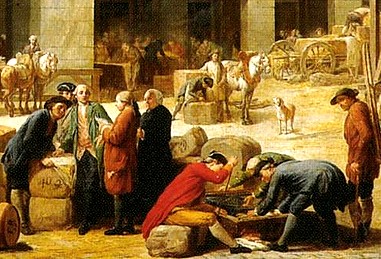
Artist: Nicholas Bernard Lepicie
Commerce in the Courtyard of the Customs House (1775)
the currency converter at the U.K.'s National Archives, this is equivalent to about £1,782.59 in 2005 money.2 Keevil notes that the things included in this chest "correspond roughly with those of Woodall's medicine chests"3.
Privateer and pirate Henry Morgan also specified the cost for a chest for his voyages in the late 17th century. His ship's articles said that each surgeon in his crew "should have two hundred pieces of eight for his chest of medicines." This was to be paid out of the first money they should take on their voyage.4 The approximate conversion of pieces of eight to pounds was 4s 6d5 (4 shillings, 6 pennies). Multiplying this by 200 gives a value of £45, which according to the currency calculator would be worth £3,737.25 in 2005 currency.
John Tweedy provided a bill for medicine to be used on the privateering ship Revenge in 1743, which came to a 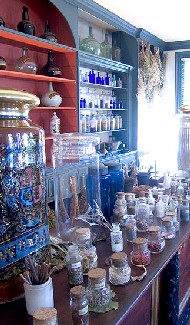
Photo: Alexis K. Feria
Hugh Mercer Apothecary
Shop, Fredricksburg, VA
total of ₤130, 2s, 9d6 which is about £11,229.56 in 2005 pounds.
When Blackbeard insisted that Charleston pay his ransom or have their harbor, ships and sailors destroyed, "they comply'd with the Necessity, and sent aboard a Chest, valued at between 3 and 400 l. [pounds] and the Pyrates went back safe to their Ships."7 This is roughly equivalent to £25,425 - £33,900 in 2005 money.
Even when converting the valuations to a common year, there is a wide variety in the price of these different medicine chests. Why this is so is not entirely clear. It may have been in part due to the location where the medicines were purchased. The hospital ship would have been buying medicines in England, the Charleston and Tweedy medicine chests would have been purchased in the colonies and Morgan's chest would probably have been bought in the Caribbean. As a result, the last three chests would likely include medicines imported from Europe to match the European standard, probably making them more expensive. It could have been due to the size and contents of the medicine chest. Since the Blackbeard chest is valued so much more highly, It may also be that the city fathers inflated the value of the chest Blackbeard took for political reasons.
Only Tweedy's bill itemizes the contents of the chest, so it isn't possible to compare them on this basis. It is interesting that Tweedy's Chest lists 121 unique medicines8 while Woodall's discusses 270 different elements9. (Woodall's chest diagram, which we will be examining in detail later in this article, only specifically details the location of 160 medicines, with 35 of the 160 being in more than one location. So his chest contains 125 distinct ingredients, more in line with Tweedy's bill. However, Woodall leaves large spaces in the chest for other ingredients that are not specified in the diagram as we shall see shortly.)
Another author who details the contents of a medicine chest is William Fabry aka. Gulielm Fabritius Hildanus. His medicine chest was to be 'Furnished Either for Sea or Land'. The 1674 printing of Fabry's book specifies an incredible 335 different elements, although there is some overlap, particularly when specifying the raw ingredients. For example, quinces are listed under the categories of syrups, seeds, fruits and oils.10 Fabry is right to differentiate them because each of these elements would require space in the chest. Fabry's military medicine chest must have been quite large and expensive to stock. However, it is unlikely that a ship undertaking a long sea voyage would have contained a large number of raw ingredients since they would go bad on a long voyage.
1 John J. Keevil, Medicine and the Navy 1200-1900: Volume II – 1640-1714, p. 102; 2 Caveat emptor when converting 17th century money value to modern numbers. Ed Fox points out that converting money from the 17th century to modern numbers is not an easy thing and any attempt to do so is "pointless and misleading." As he notes, "1 month's wage for a sailor = [the cost of] 5.8 shirts = [the cost of] 456 loaves. Or, 1 shirt = [the cost of] 78.6 loaves. In the present day, 1 month's wage for a sailor = [the cost of] 111.5 shirts = [the cost of] 1,115 loaves. Or, 1 shirt = [the cost of] 10 loaves." For a full explanation of why this is so, see Ed's comments in this post at the Authentic Pirate Living History Facebook page. 3 Keevil, p. 102 4 Thanks to Ed Fox for suggesting this number during a discussion on the Authentic Pirate Living History Facebook page, gathered 8/26/14, 5 Richard B. Sheridan, "The Doctor and the Buccaneer: Sir Hans Sloane's Case History of Sir Henry Morgan, Jamaica, 1688", The Journal of the History of Medicine and Allied Sciences, Volume 41, p 81; 6 John Franklin Jameson, ed., "158. John Tweedy’s Bill for Medicines. November 8, 1743". Privateering and Piracy in the Colonial Period Illustrative Documents, p. 461; 7 Captain Charles Johnson, The general history of the pyrates, 3rd Edition, p. 74; 8 Jameson, p. 457-61p; 9 See John Kirkup's Introduction to the reprinting of John Woodall's book, the surgions mate, p. xviii; 10 Guliielm. Fabritius Hildanus aka. William Fabry. Cista Militaris, Or, A Military Chest, Furnished Either for Sea or Land, 1674 Edition, p. 13-21

